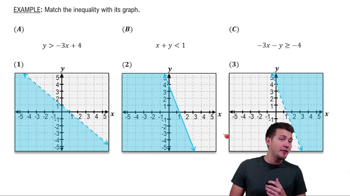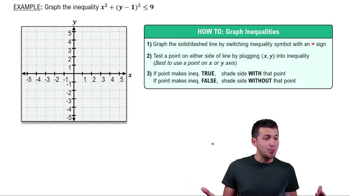Table of contents
- 0. Review of Algebra4h 16m
- 1. Equations & Inequalities3h 18m
- 2. Graphs of Equations43m
- 3. Functions2h 17m
- 4. Polynomial Functions1h 44m
- 5. Rational Functions1h 23m
- 6. Exponential & Logarithmic Functions2h 28m
- 7. Systems of Equations & Matrices4h 6m
- 8. Conic Sections2h 23m
- 9. Sequences, Series, & Induction1h 19m
- 10. Combinatorics & Probability1h 45m
7. Systems of Equations & Matrices
Graphing Systems of Inequalities
Problem 52
Textbook Question
Graph the solution set of each system of inequalities.
y>x2+2
y≤x−2
 Verified step by step guidance
Verified step by step guidance1
Step 1: Begin by graphing the boundary of the first inequality, \( y > x^2 + 2 \). The boundary is the parabola \( y = x^2 + 2 \). Since the inequality is 'greater than', use a dashed line to indicate that points on the line are not included in the solution set.
Step 2: Determine which side of the parabola \( y = x^2 + 2 \) to shade. Choose a test point not on the parabola, such as (0,0). Substitute into the inequality: \( 0 > 0^2 + 2 \) which simplifies to \( 0 > 2 \). This is false, so shade the region above the parabola.
Step 3: Next, graph the boundary of the second inequality, \( y \le x - 2 \). This is a straight line with a slope of 1 and a y-intercept of -2. Use a solid line because the inequality is 'less than or equal to', indicating that points on the line are included in the solution set.
Step 4: Determine which side of the line \( y = x - 2 \) to shade. Use the test point (0,0) again. Substitute into the inequality: \( 0 \le 0 - 2 \) which simplifies to \( 0 \le -2 \). This is false, so shade the region below the line.
Step 5: The solution set of the system of inequalities is the region where the shaded areas from both inequalities overlap. This is the area above the parabola \( y = x^2 + 2 \) and below the line \( y = x - 2 \).
Recommended similar problem, with video answer:
 Verified Solution
Verified SolutionThis video solution was recommended by our tutors as helpful for the problem above
Video duration:
7mPlay a video:
Was this helpful?

 7:2m
7:2mWatch next
Master Linear Inequalities with a bite sized video explanation from Patrick Ford
Start learning





